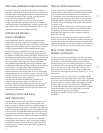
24
Wall Case Installation Data (Continued)
For new construction, early planning with the architect is
necessary. Unit location, electrical connection locations and
wall openings of the proper dimensions are essential to avoid
the necessity of rework, fillers, framing, moving electrical
outlets and other expensive modifications.
For existing construction it is important that carpentry,
masonry and electrical work be performed by competent,
qualified personnel. Since installations in existing construction
may involve removal of building material from the structure,
locating the wall case must be done correctly.
Architectural Window/
Louver Installation
Many installations utilize an architectural window/louver
combination to enhance the exterior appearance of the
building. The exterior grille for the air conditioner is built as an
integral part of the window frame. An internal drain system
is highly recommended for these installations (see page
36). When this type of installation is made, there must be
provision in the grille work for condensate water to drain to
the exterior (including the overflow relief drain holes) and not
be routed back into the interior of the building or into the wall
cavity. Failure to allow for the drainage of condensate water
can cause extensive damage to structural components.
The problems associated with the lack of condensate drain
consideration often show up shortly after the air conditioners
are turned on in a new building. New buildings that have
been virtually wide-open during construction have a
significant amount of moisture in the air and in the building
components that the air conditioners start removing as they
operate. The free area in the louver section must also comply
with the requirements shown on page 41.
The wall case should be anchored to the architectural
window/louver section to reduce air infiltration and
excessive vibration of the chassis and wall case during unit
operation. Field-fabricated and installed case angles are
the recommended method of securing the wall case to the
window/louver framework.
Window, Curtain and Panel
Wall Construction
With this type of construction, provision for support of the
unit, other than by the wall itself, is often required. Such
support may be in the form of wood or metallic material of
the proper thickness to maintain a level case. This additional
support should be located both near the wall and at the front
of the wall case. Sub-base (RAK204 Series) with four leveling
legs provides an excellent support for the unit in this type of
installation. See page 28 for details of this type of installation.
In existing construction, common practice is to remove a
pane of glass, metal, wood, or other construction material
and build a frame around the wall case. Similar filler panel
material may be installed around the case for appearance
and weather seal.
Masonry Wall Construction
The wall case should be installed during construction and
lintels should be used to support the blocks above the wall
case. The wall case will not support the concrete block.
The installation instructions show how the wall case must
be secured to the masonry and caulked. Do not remove the
cardboard stiffener supplied with the wall case until ready
to install the chassis. See page 29 for details of installation
in masonry wall.
For existing masonry construction, wall openings must be
made by removing concrete blocks to achieve the proper-
size opening. Consult the builder, architect or owner to
determine the necessity for lintels to support the block
above the wall case.
Anchor bolts are normally required to secure the case to
the wall and shims may be required to prevent distortion of
the wall case when securing the wall case to the wall. Field-
supplied case angles can be used to position and secure the
wall case to the wall and to cover oversized wall openings.
Brick, Frame, Stucco and
Shingle Construction
For new construction, the opening for the wall case should
be framed and the wall case inserted into the opening during
construction. Lintels should be used when the building
material is heavy and is not self-supporting (such as brick).
The wall case will fit an opening of six courses of standard
brick or five courses of jumbo brick. Wall framing in this
type construction is normally on 16" centers and the wall
case will fit a framed opening spanning three 16" O.C. 2" x 4"
stud spaces.
For existing construction, the indoor and outdoor wall will
need to be cut out, allowing for clearances of 1/8" on all sides
of the wall case. Work should begin on the inside wall. Cut the
correct dimensions and mark (using drill holes) the outside
wall from each corner of the inside cutout. Studding that
interferes with the opening must be removed and a suitable
frame constructed to secure the wall case and provide
adequate support for case and chassis.
As shipped, the RAB71A Series or RAB77 is ready for
installation.


















